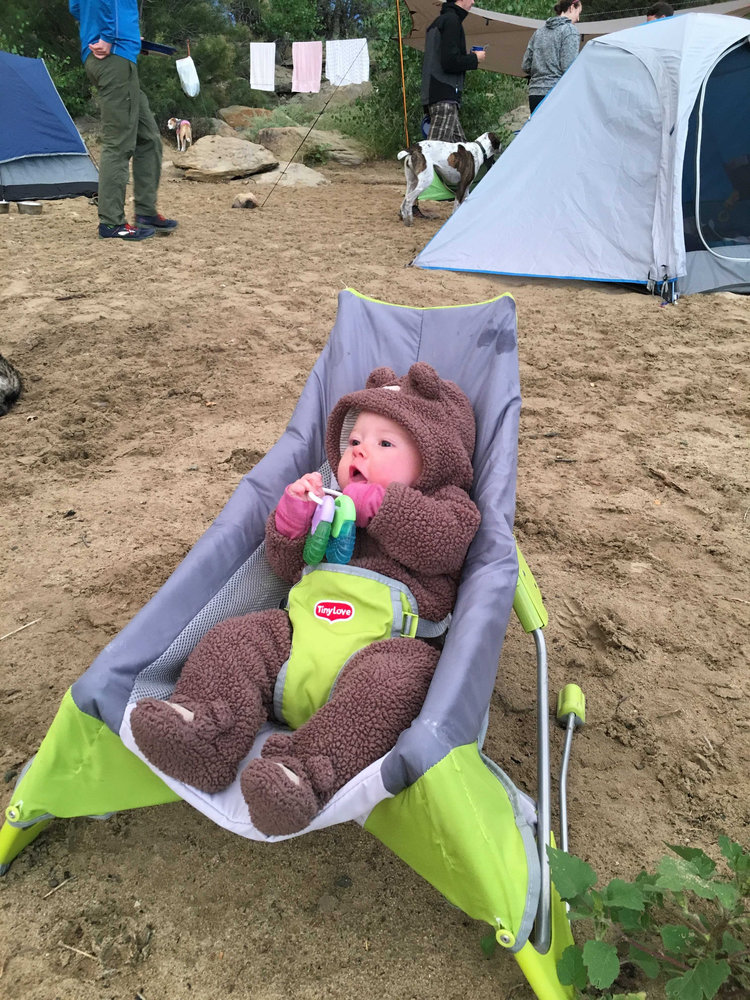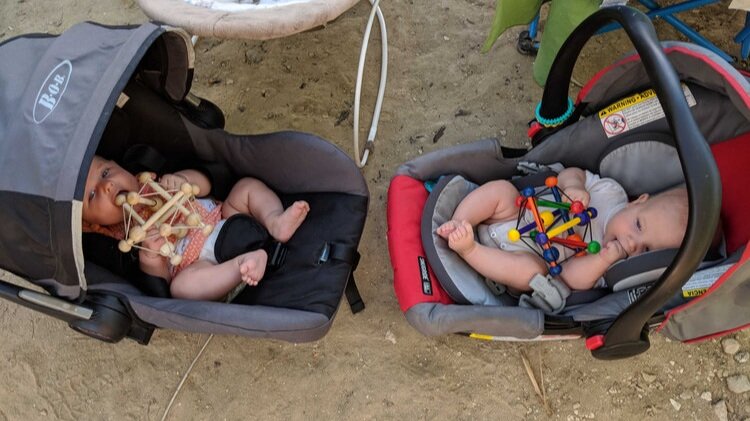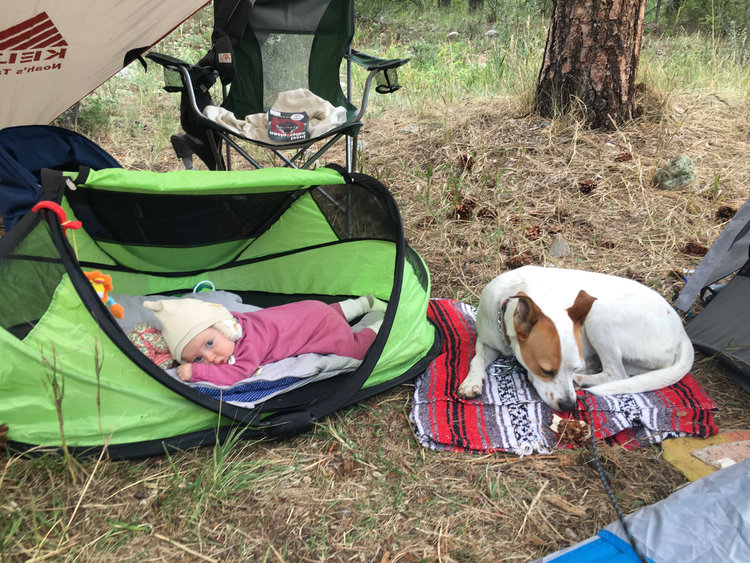Are you skeptical about getting into the wilderness with your kids? Or do you want to, but not sure how to deal with all the obvious discomforts of camping with or without children? I’m here to help you solve it all. Read on for the not-so-great sides of camping that I think most parents can relate to and how to fix it and make it an enjoyable trip.
Read Morepacking light with compact sleep gear for baby and toddler
3 Tips for Packing Light with Compact Camping Sleep Gear for Baby and Toddler
3 tips on how to pack light with excellent compact camping sleep gear for baby and toddler
Read More8 Tips and packing Essentials for CAMPING with Baby for a Great First Trip
Updated May 2021
Are you thinking about camping or overlanding with your newborn or older kids, but just finding it all a bit too overwhelming? Or do you worry about what gear to bring for baby? Or where to go? I hear you! I've been there. Rest assured, I am here to provide you with great tips tat worked for us on camping with, now 3, babies including essential gear and considerations.
Remember, camping and overlanding come in many forms. You set your own rules and comfort level. I’ve included the need-to-have basics for baby and mama to bring when camping with an infant - it worked for us for primitive camping and will work anywhere.
Baby E taking in the view in her foldable and compact Tiny Love bouncer. This was a great tool to have for camping with baby for meal prep, setup and packing. However, we never used it for baby O - his car seat worked just as well and had the canopy for extra sun protection. I recommend this bouncer if your car seat doesn’t detach.
Camping with an infant or baby does change the experience, but not for the worse - if you come prepared.
This post assumes that you know what to pack for yourself. If not, get inspired by our setup list and stay tuned for our ‘then and now’ setup post. (There are also great camping packing lists to be found on Pinterest, but stick to the basics.)
1. Set the right expectations and prepare yourself for a slower pace when camping with baby
If you're used to camping without a baby, you already have and know the basics. Keep doing what you did, but be prepared for everything happening at a much slower pace. You'll be surprised at how many nursing/diaper change/potty stops you suddenly have to do. And that's okay if you prepare yourself for another 1 hour of travel time.
Arrive before 5 PM and bring a pre-cooked meal!
Plan for early dinners (or early meal prep at least so you don't have to fumble in the dark in your primitive kitchen when the kids are getting hungry (read: hangry)). (Check out my great tips on easy family meal planning and watch out for my extensive e-guide to confident meal planning). And plan to arrive at your camp spot before dinner and bedtime. Our babies would always get very hungry around 5PM and setup time is usually much slower with babies. If you have room, bring a pack'n'play, play yard or a baby carrier to keep baby safe and happy while you set up. Delegate tasks to your older toddlers or kids to engage and distract them such as bringing in the bedding, collecting sticks and wood for a fire, laying out a blanket for baby, play with baby, give the dog water etc.
A car seat is great when camping with infants and baby because it provides a safe and familiar space for baby while you prepare meals, setup or pack down camp. The canopy is a great plus for sun protection.
2. Where to camp for the first time with an infant or baby
I've heard from new mamas who used to go camping that they are not sure where to go now. Many other moms will advise you to stick to developed sites with running water and toilets. I'd say you should go exactly where you want to.
For newborn and infants, I do recommend keeping the driving time to a maximum of 2-3 hours if possible. If you are going on a longer trip, then plan to do long breaks. We have been able to avoid having to stop to nurse, sooth, entertain or change diapers by sticking to 2-3 hour drives and arriving before 5 PM.
We started out pre-baby with developed campsites around NM and neighboring states, some with toilets, some not. Within a year or two we were primarily camping in the wilderness or in primitive sites for privacy as well as prime location and views. You have to do more homework for primitive off-site camping to at least have some ideas of where to set up camp, but also to be sure you're allowed to camp there. (Check our my step-by-step guide to finding your own primitive camping spots). That's a luxury problem we have in the Southwest. I imagine the east and west coast have fewer options for wilderness camping - which probably makes it easier to decide where to go.
Our first morning camping with baby E as an infant (4 months). We woke up to a beautiful sunny meadow along the Pecos River near Santa Fe, NM. We stayed fairly close to home (1,5 hours) in case the night turned out to be awful. We chose a secluded spot for less neighbor noise and more privacy.
We started out with a book about recommended campsites in our state. I can highly recommend getting that for easy getaways and decision making. They often describe the traffic the site gets as well as all the amenities (or lack thereof), including where to stock up on firewood, food, diapers etc. in case you forget something. Friends and co-workers are also tremendous resources and will often have a favorite spot they recommend or will even take you with them on their next trip.
This is the book we used until we got confident enough for finding our own spots: “Best Tent Camping: New Mexico: Your Car-Camping Guide to Scenic Beauty, the Sounds of Nature, and an Escape from Civilization” by Monte Parr.
3. When to go camping with an infant for the first time
We’ve learned that 6-8 weeks is a comfortable time to start taking your infant camping. We took baby O at 6 weeks which was doable, but a tough experience because our location was colder than predicted.
A good rule of thumb is to go when baby no longer needs poopy diapers changed at night and when you can nurse lying down, hence stay warm in your sleeping bag. At 6 weeks baby O still needed poopy diapers changed in the middle of the night which is no picnic in the park (pun intended). At 8 weeks, he had matured a lot more and still small and sleepy enough to just hang out in a carrier on me. Our third baby didn’t need any diapers changed at 6 weeks during the night, and I could comfortably lie down while nursing her, so babies are different too.
We took our pre-schooler camping at 4 months for the first time which was fine as well. But at 4 months they need more entertainment and are more aware of their surroundings. If you know the night temperatures will drop below the 40s, I would wait until 4 months. But clothing and a space heater help a lot and babies are sturdier than they look. (We have winter camped with a 9 month old in the snow!)
4. Stay close if you are nervous about camping with your infant or older kids
I understand that with longer workweeks and sometimes multiple jobs, it seems overwhelming to leave town for the weekend. And with a newborn and kids in general, it’s easy to feel too tired to plan a weekend away. It’s also difficult to predict how the kids react to the new surroundings, to being cold or hot etc. The fix: start slow and small. Stay in your back yard or just 1/2-1 hour away to do a practice run. This brings peace of mind if you are new to camping or nervous about how the baby will do. But I promise you, baby will do great as long as you are relaxed. If being close to home makes you calm, then baby will be calm. However, remember that babies and kids are very adaptable and adventurous. They just want to be close to you, so they will tag along for anything.
5. Set up at least 2 diaper changing stations at your campsite
My fellow camping mom friends agree that you cannot have enough diaper changing stations. It’s deeply frustrating always having to get in and out of the tent or the car when you need a wet wipe or to change a diaper. We keep a wet bag with a 1-2 day supply in the tent and the same in the back of the car. We use the tailgate because it’s a convenient height. You can also use a camping table or a chair. We also keep wet wipes at the front seats for those messy snacking hands on the go.
6. Where should baby sleep while camping?
There are many ideas for a good camping bed for baby. We have tried and tested a lot because we have borrowed different gear and have had changing setups. It also depends on your baby. E as a baby was extremely independent. She was a calm and content baby who would usually stay put. We used her bassinet (stroller attachment) to put her in for setup and packing. She also slept in her bassinet inside our 2 person tent the first night, but we quickly moved her to our bed where she would stay warmer. However, she soon demanded her own space, so we got her a pack’n’play after 6 months. We also had her in the KidCo PeaPod tent once, but it seemed easier to have her between us on our mats in our small 2 person tent.
The Pack’n’play is bulky and slows down an overlanding setup, but great if you have room and time. Baby is off the ground and the mesh sides allow for a breeze in warmer temperatures. A bassinet is great for smaller babies that don’t move too much, but I only recommend for warmer temperatures since it’s not insulated or off the ground. Our friends would bring their Rock’n’play which also worked great.
For the more dependent sleepers, I recommend having baby next to mama on a double mat or on his own mat. We had no choice with baby O, but it worked out wonderfully because I didn’t have to get up at night to nurse him and I could easily check to see if he was too warm or too cold.
If you are nervous about co-sleeping, get a little travel bassinet for your baby. I make sure to place baby between our pillows so I don’t accidentally roll onto her or cover her with my blanket. You can place baby in an insulated suit or in a fleece suit inside a small sleeping bag next to you so baby doesn’t sleep inside your bag which can be dangerous.
Make sure to get a mat with a good R-value (insulation) if you will be camping in colder temperatures. Please be aware of the hazards of co-sleeping while camping since sleeping bags can be more restraining and suffocating if you don’t take precautions.
We currently camp in our newly build offroad trailer where there is no room for a pack’n’play. At 6-8 weeks, baby J has been sleeping between our pillows in our bed or in her Snuggle Me pillow (mostly for day naps). A Dock-a-tot pillow or a travel bed that lives on the mattress are other great alternatives, but they just take up too much space in our bed. It will probably be a while before we can move her to the top bunk with her siblings.
NOTE: Our third baby seems to like a Shusher sound machine. We never used a noise machine for our other kids, but I imagine that some white noise could helps babies and kids sleep better by drowning out new noises and adult voices talking.
Go to my in-depth post on compact camping sleep gear for baby and toddler
Camping sleeping gear for baby changes with age and temperatures. At 12 weeks in July, baby O had graduated to his own (sister’s) sleeping bag (Kelty Kids 40) while still wearing a fleece bunting suit and wool PJs underneath. This is a good setup when the night temperatures can be warmer because you can easily take baby in and out of the sleeping bag.
We tested this KidCo PeaPod collapsible tent when camping with baby E for the first time. It worked quite well as a compact alternative to a play yard and place to set baby down. She would sit and play in it with her baby friend on a different trip. It’s fairly sun protected and has a bug mesh that zips up. The inflatable cushion in the bottom makes it a comfortable alternative to an infant bed if you have room in your tent. But be aware, it’s slippery without a cover.
7. The basics camping packing list for baby:
Here is what I pack for baby for a weekend camping trip in the high desert/mountains (day temperatures in the 60s-70s and nights in the high 30s or 40s).
Clothing:
o 4 onesies - long-sleeved (merino wool is great for temperature regulation)
o 2 PJs (that open at the crotch or have zippers)
o Fleece bunting suit
o 2 pants (thick if crawling)
o 2 pairs of socks
o sunhat
o 2 warm hats (one thin balaclava)
o 1 pair Warm booties (for night time or outdoor play if not walking)
o 1 pair waterproof/resistant shoes or boots (if walking)
o mittens (if bundle suit doesn’t have it or baby is bigger)
o Rain suit or water repellent bundle suit
o Down suit for sleeping in/extra warm sleep sack/sleeping bag for baby.
o 2 Sweaters/cardigans
o Jacket /windbreaker
Toiletries:
o Diapers - 10/day the first year
o bags/zip lock bags for poopy diapers
o 3 packs of wet wipes
o Tylenol and syringe
o 3 Wash cloths + travel sized baby soap for heavy washing (dirt, blow outs etc.)
o Tweezers + first aid kit (pointy one for splinters/thorns)
o Toothbrush
o saline drops and snot sucker
o Benadryl
o sunblock (mineral-based for baby)
o 2 hand sanitizers
Gear:
o Baby snacks
o Rock’n’ play/Pack’n’play /bassinet/Kidco Peapod/ mat for sleeping
o Umbrella for sun protection
o Nice-to-have: Play Yard: Pack’n’play/Summer Infant Collapsible Play Yard/collapsible ball pit/Kidco Peapod
o Picnic blanket
o 2 Muslin cloths
o Noise machine (if you use this)
o Portable high chair / Bumbo (a car seat or bouncy chair works as well)
o Nice-to-have: Hammock
o Few Toys and books - see my jar of toys that we would bring for baby age 6-18 months.
Check out my 13 essentials for camping and overlanding with a baby and a toddler
We used this Summer Infant Play Yard a lot when camping as a group with babies. It folds to the size of a camping chair and has a protective sun shade as well as ground cover. This makes setup and packing much easier when camping with mobile babies or camping on sand/dust or wet grounds. It may quickly get boring for baby to be in there alone, so bring a friend or a great toy.
There is nothing a good swing in a hammock can’t fix when camping with infant, baby and toddlers. It is fun, soothing, cozy and social. We keep two compact travel hammocks in our car always. They are easy to setup between trees, poles and roof racks.
8. The extras camping packing list for Mama:
o Baby carrier (I used a Solly wrap and Beco Gemini for early days and an Ergo 360 for 2-3+ months)
o 1 Nursing sweater - heaven-sent for camping both at night and around the campsite
o 1 regular sweater in case of spills
o 2 v-neck/low cut t-shirts for easy boob-access
o 1 pair of shorts
o 1-2 pairs of pants (leggings and hiking pants)
o Ski underwear bottoms (insulating layer as PJs bottoms if cold. otherwise use leggins)
o Nursing/car seat cover (like Milk snob) for multipurpose cover, wind protection when nursing and wind/sun protection when napping if using baby’s car seat
o Stadium seat for long night time nursing sessions or camping chair if room inside your tent.
o Waterproof clogs/crocs or rain boots for easy in-and-out of the tent and limited bending when carrying baby
o Aquaphor for nipples/lips/baby
o Water bottle (no spill!)
o Tarp - you can get very compact ones that are lifesavers in rain or shine. You want to keep your little ones out of the sun as much as possible.
Check out my 5 camping favorites for the breastfeeding mom
The Milk Snob nursing cover and our Kelty Tarp are always in use when camping with a baby and small kids.
Happy camping everyone!






















